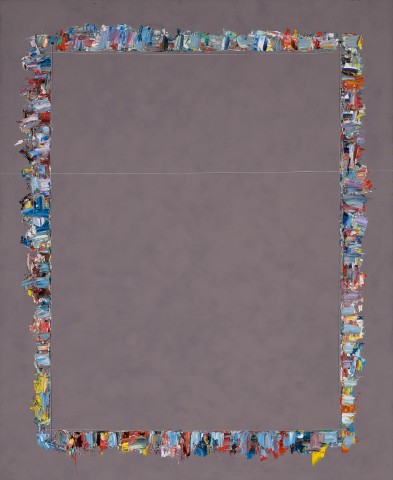PAINTING, 1978
PAUL PARTOS
oil, string and pins on canvas
137.0 x 111.5 cm
signed and dated verso: P Partos 78
Probably: Pinacotheca, Melbourne
Tolarno Galleries, Melbourne
The National Australia Bank Art Collection, acquired from the above in August 1979 (label attached verso)
Eureka! : artists from Australia, Serpentine Gallery, London, 13 March – 25 April 1982, Institute of Contemporary Arts, London, 24 March – 25 April 1982 (label attached verso, illus. in exhibition catalogue, p. 31)
The Seventies: Australian Paintings and Tapestries from the Collection of National Australia Bank, National Gallery of Victoria, Melbourne, 15 October – 28 November 1982
Collection of Modern Art in the Seventies, Latrobe Valley Arts Centre, Victoria, 9 May - 2 June 1985
The Seventies: Australian Paintings and Tapestries from the Collection of National Australia Bank, Geelong Art Gallery, Victoria, 30 April - 29 May 1988
'The Seventies' Exhibition: Selected Paintings from the National Australia Bank Collection 'Modern Art of the Seventies', Caulfield Arts Complex, Melbourne, 18 January - 11 February 1990, cat. 17
Lindsay, R., The Seventies: Australian Paintings and Tapestries from the Collection of National Australia Bank, The National Bank of Australasia, Melbourne, 1982, pl. 70, p. 83 (illus.)
'Insight into Recent Art', The Express, Victoria, 2 May 1985, p. 12
There have been many times over almost 200 years when the death or end of painting has been declared. Paul Delaroche claimed ‘From today, painting is dead’ when he saw the first daguerreotype around 1840.1 Marcel Duchamp rejected painting and in 1917, his porcelain readymade, a urinal titled Fountain and signed R. Mutt, defined his future. The great American Minimalist, Donald Judd, thought painting was finished, something he and the proponents of Conceptualism had in common. None of this was lost on Paul Partos. Painting, 1978 is from a crucial time for the artist – his interest in Conceptualism and new international currents had been experienced firsthand from the mid-sixties.2 It wasn’t an impulse reaction in the wake of the much-vaunted international exhibitions travelling to Australia.3
Partos arrived in Australia from Bratislava, Czechoslovakia, as a six-year-old. In 1959 he enrolled at the Royal Melbourne Institute of Technology – other students included Lesley Dumbrell, Gareth Sansom, Robert Jacks and George Baldessin. His expressive figuration revealed an emerging painter of prodigious talent. Melbourne’s Gallery A held a sell-out exhibition in 1965 and Gallery A in Sydney held a solo exhibition later in the year. His expressionist inclinations soon cooled and in 1968 he made Vesta II which was included in The Field exhibition.4 It is a rectangular sprayed painting and within it is a smaller empty rectangle where the wall on which it hangs is visible. The idea of the work framing itself was already in play. Black Screen, 1968 – 69 is a vertical rectangular sculpture where nylon mesh is stretched over a wooden frame which literally frames a delicately poised translucent folded form.5
In Painting, 1978, painting becomes a visualised process and system – one able to inquire into and be about itself. It is a timely inquiry about the nature and physical presence of painting at a time of considerable theoretical posturing about art and its future, both in Australia and abroad. Partos was a gifted painter and he never dismissed painting’s sensory and emotional potential – we are certain of this from his formative figurative work and what followed Painting.
But here Partos develops a visual and conceptual proposition which is delineated and ordered – where the act of looking and thinking is never superseded by the expressive capacity of paint itself and any subject it might depict. Nothing exists beyond the painting itself. It becomes a masterly combination of the artist’s natural painterly impulses and his strong intellectual inquisitiveness.
1. Paul Delaroche (1797 – 1856), celebrated French painter of historical subjects.
2. Between 1965 – 66 Partos was in Europe and London. He was living in New York City in 1970 – 72.
3. Charles Green, ‘Notes on the Centre: Two Decades of American Painting in Australia, 1967’,Tate Papers, no.32, Autumn 2019.
4. The Field, National Gallery of Victoria, 1968, a landmark exhibition of Colourfield abstraction to mark the opening of the NGV at its new StKilda Road premises. Vesta II, 1968, synthetic polymer paint on canvas, collection of the Art Gallery New South Wales
5. Black Screen, 1968 – 69, synthetic polymer paint on nylon mesh on wooden framework, collection of Geelong Art Gallery, Victoria Corio 5 Star Whiskey Prize, 1969
DOUG HALL AM
